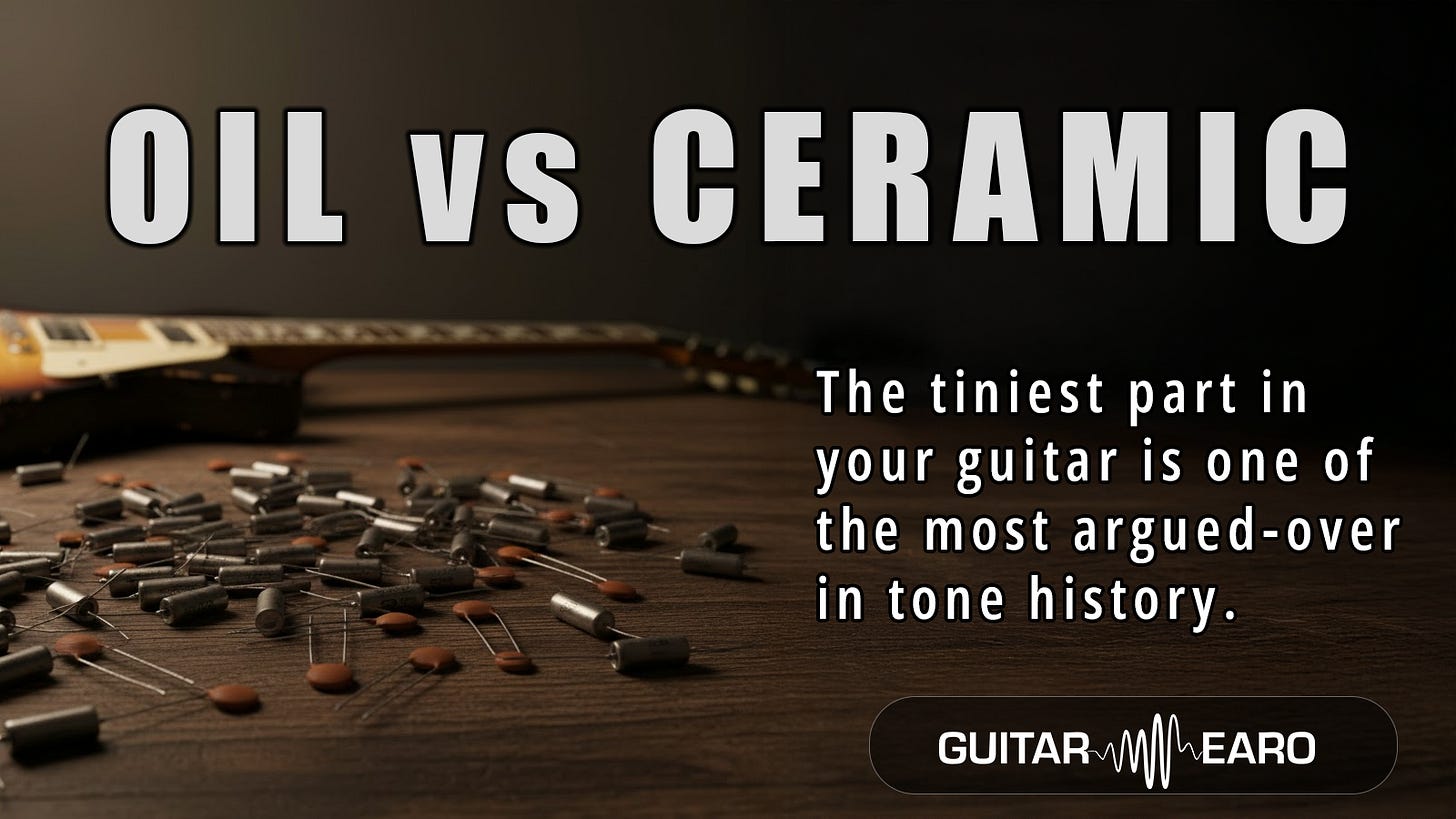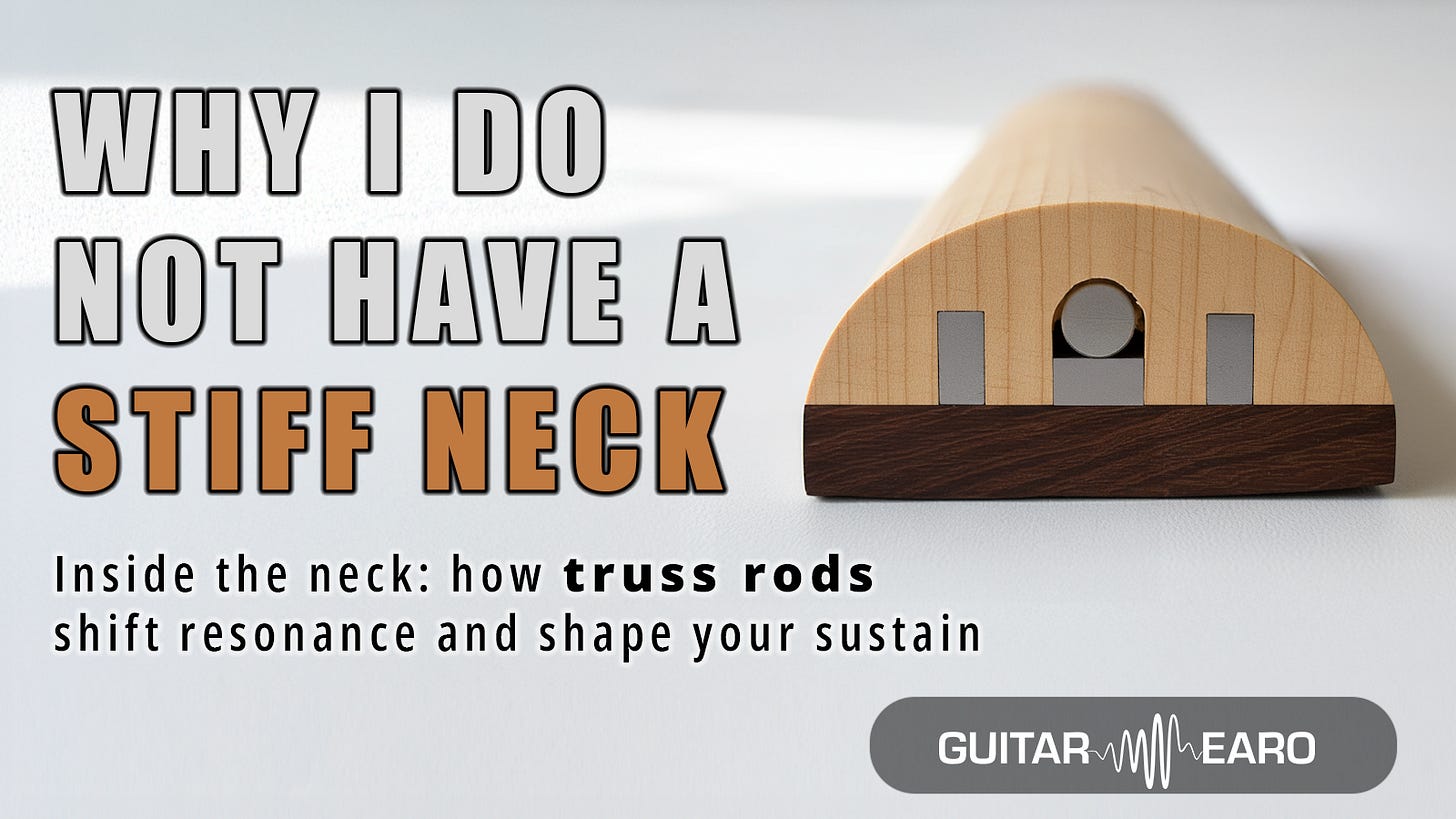When guitarists talk about “mojo,” they’re often referring to something intangible: feel, groove, attitude.
But sometimes, mojo is mechanical.
Keith Richards’ “Micawber”, a 1954 Fender Telecaster modified beyond recognition, is a case study in how physics, hardware, and tuning converge to create one of rock’s most distinctive voices.
💡 If this kind of detail makes your inner tone scientist light up, you’ll love my deep dives on guitars. Subscribe below to get the next one direct to your inbox.
1. Origin Story: A 1954 Tele Becomes a Weapon
In 1971, Eric Clapton reportedly gifted Keith a worn butterscotch Telecaster as a 27th-birthday present.
Within a year, Richards and his tech Ted Newman Jones had turned it into a stripped-down, five-string, open-G tuned rhythm machine.
The low E string was removed entirely, leaving the tuning G–D–G–B–D, the core voicing of Richards’ open-G chord shapes.
Without the floppy low E, the instrument’s low-frequency damping changed dramatically: less sympathetic resonance in the 82–110 Hz range, and a much tighter low-mid response around 150–250 Hz.
This created a tone spectrum perfect for his percussive “chuck” rhythm attack.
In short: no low-end mud, just focused midrange.
2. The Hybrid Pickup System: Gibson Meets Fender
By late 1972, Richards had broken every brand orthodoxy by installing a Gibson PAF humbucker in the neck position, mounted upside-down, with the pole pieces facing the bridge.
Why upside-down?
Two reasons are likely:
String-to-magnet alignment.
Fender’s wider string spacing (~52 mm at bridge) meant flipping the humbucker brought the polepieces closer to ideal alignment under each string.
Micro-shifted tonal focus.
The reversed magnetic field orientation subtly alters the way the humbucker senses higher harmonics.
Measurements by pickup builders show that flipping the coil orientation can shift the resonant peak by ~100–150 Hz, not enough to be night-and-day, but enough to change “bite.”
Meanwhile, the bridge pickup was swapped for a hotter Fender lap-steel / Broadcaster-style unit.
Those lap-steel coils are wound to about 10 kΩ versus the stock 6–7 kΩ of a Tele bridge pickup, pushing more midrange and less ice-pick treble.
The two together, vintage PAF in neck, lap-steel single-coil in bridge, created a wide-band stereo pair within one guitar: creamy 3 kHz “PAF bloom” blended with the 4–5 kHz Fender twang spike.
In the middle position, the wiring kept both pickups in parallel, not out-of-phase, so that instead of canceling frequencies, they combined to form a slightly hollow, hi-fi tone.
Players describe it as “piano-like clarity.”
Technically, the two pickup impedance curves complement each other: the humbucker’s roll-off above 5 kHz fills the midrange notch of the single-coil, yielding that full yet articulate composite sound.
3. The Brass Bridge Experiment
Sometime around 1981, Jones replaced the standard Tele bridge with a solid brass plate and five individual brass saddles (one per string).
The removed low-E saddle was deliberate: in an open-G setup, that saddle simply wasn’t needed.
Brass, with roughly 3× the mass and 1.4× the density of the original steel plate, alters both mechanical impedance and damping.
Empirical tests on Tele bridges (notably those by Glendale and Callaham) show that switching from steel to brass:
Increases total bridge mass → slightly longer sustain envelope (by 5–8%)
Reduces high-frequency “Q” resonance around 6–7 kHz → smoother treble
Adds ~0.5 dB energy retention in the 2–4 kHz band → perceived “sweetness”
For a player like Richards, whose attack is all about the transients of muted chords, this matters: the brass bridge rounds the front-edge transient and extends note decay just enough to make the groove breathe.
4. The Five-String Setup and String Dynamics
Richards uses a custom five-string set (.011–.042) with a wound G.
That wound third string stabilizes intonation in open-G chords and increases tension uniformity across the remaining strings.
Here’s the approximate tension profile (in open G, assuming 25.5″ scale):
Notice the uniformity, all within a ~2.5 lb window, meaning every string vibrates with nearly equal dynamic compliance.
That gives Micawber its even, chime-like chord attack.
A standard 6-string setup, by contrast, usually has a low E around 21 lb tension and a high E at 16 lb far more uneven.
This balance makes the open-G tuning feel taut yet percussive, and when strummed through clean amps, each note retains definition instead of blending into a low-end cloud.
🧠 For subscribers who want the “physics behind feel.” Get it here
5. The Amplification Chain: Clean but Loud
Richards’ rig has often been misunderstood.
Most assume his tone comes from overdriven amps.
In fact, he runs relatively clean through Fender Twin Reverbs and vintage Ampegs, relying on speaker breakup and natural tube compression, not distortion.
Because of this, Micawber’s pickup balance and midrange tuning become the entire tone engine.
No pedal coloration, minimal gain stacking: just clean headroom amplifying wood and wire.
The result: harmonic structure dominated by the second and third partials (2f and 3f) instead of the fifth and seventh: the exact recipe for the Stones’ “thick but jangly” rhythm tone.
6. The Physics of “Less Strings, More Mojo”
From an acoustical standpoint, removing one string changes the vibrational coupling of the bridge and body.
Finite-element models (see Gore & Gilet, Contemporary Acoustic Guitar Design, 2011) suggest that each additional string adds both mass and lateral damping at the bridge.
Removing one string reduces average modal overlap in the 200–400 Hz region, tightening bass response and shifting node points upward.
That’s why Micawber, despite being a Tele, behaves more like a semi-hollow in its feel: lively and microphonic.
You can actually hear sympathetic resonances around 400 Hz when playing unmuted chords; those are the same partials that give “Brown Sugar” its clanging resonance.
7. Legacy: The Blueprint for Modern Hybrid Guitars
When Richards mixed a Gibson neck pickup with a Fender bridge pickup in 1972, he inadvertently invented the Tele-Gib archetype: decades before boutique builders made it fashionable.
The concept of combining disparate tonal systems (PAF + single-coil) to achieve midrange fullness became a template for countless modders.
Micawber also anticipated trends like:
Brass hardware for sustain and warmth (now common in boutique Teles)
Hybrid pickup wiring (seen later in PRS and Suhr models)
Open tunings and string reduction as tonal tools, not just stylistic ones
It’s fitting that Micawber ended up displayed in the Metropolitan Museum of Art — not as a relic, but as proof that a rock instrument can be both experimental and timeless.
Takeaway
“Micawber” isn’t myth: it’s applied acoustics.
Keith Richards distilled the Telecaster to its sonic essentials: one fat pickup, one bright pickup, five strings, open-G resonance, and no nonsense in between.
Every modification had a physical consequence: all pointing toward clarity, groove, and midrange dominance.
That’s why half a century later, those first chords of “Brown Sugar” still sound like nothing else.
Less strings, more mojo.
But also: more science than anyone gives it credit for.
❤️ If this kind of tone archaeology hits the spot, subscribe to Guitar Earo: where we dissect one legendary instrument each week with real data, not nostalgia.



